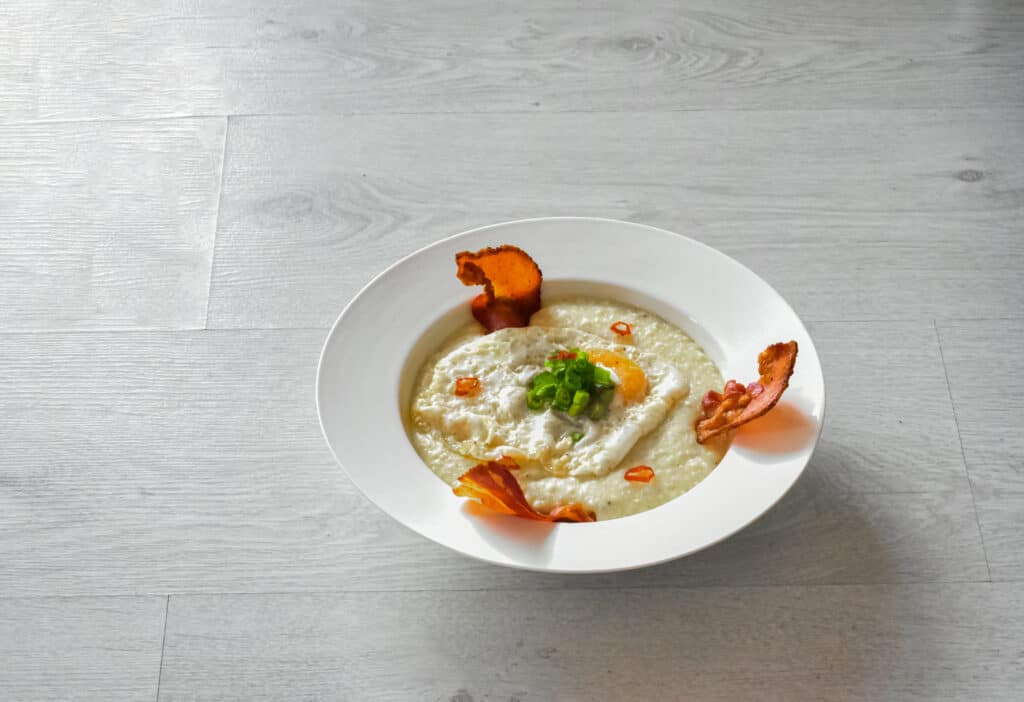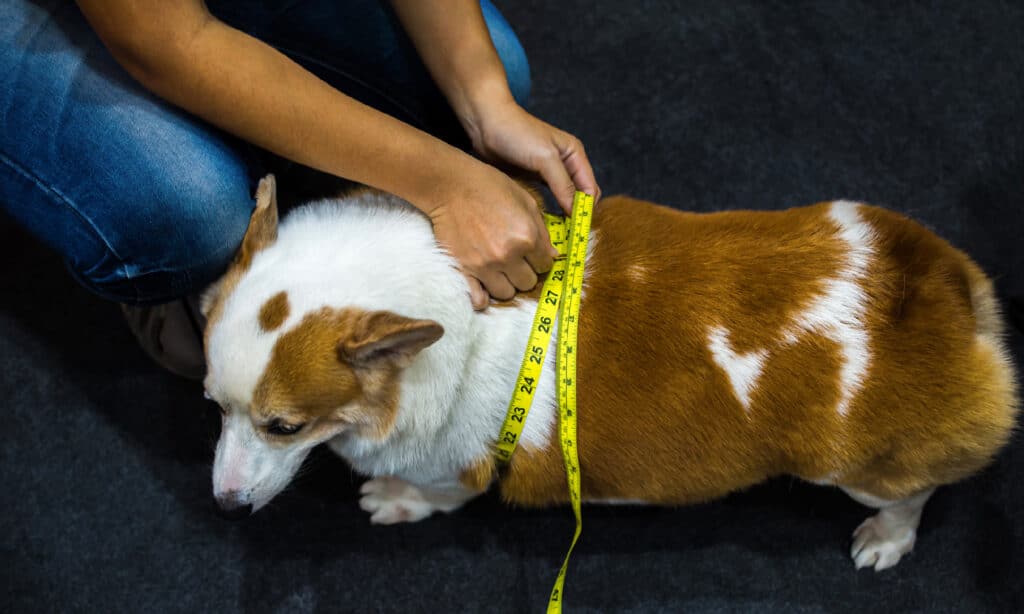Have you ever eaten grits whilst your dog attempts to perform telekinesis on the bowl? You can’t blame them, the smell of tasty grits with cheese or shrimp is undeniably mouth-watering, but can dogs eat grits, or are they dangerous?
Let’s discover how Lassie can enjoy grits too.
Can Dogs Safely Eat Grits?
Yes, dogs can safely eat small amounts of unseasoned plain cooked grits. Grits are warming and filling so dogs tend to like them, but because they have a large number of carbohydrates, regular grits may lead to weight gain.
The ASPCA recommends treating foods like grits as no more than 10% of their daily food. Dogs should eat a well-balanced diet that contains all the nutrients they need, which can be store-bought commercial dog food or homemade.

Plain grits are safe for dogs, but people enjoy seasoning their grits with sugar, bacon, shrimp, syrup, salt, pepper, or gravy and these additions are not dog friendly.
©Garzing/Shutterstock.com
What Are Grits?
Grits are porridge made from cornmeal that’s been cooked until it’s soft. Plain grits are safe for dogs, but people enjoy seasoning their grits with sugar, bacon, shrimp, syrup, salt, pepper, or gravy and these additions are not dog friendly.
Grits are prepared in water or milk and stirred over heat until they’ve turned thick enough to spoon up. They’re very popular in the American south, but the first grit dishes were made by Native Americans who in turn taught the colonists in the 1600s.
The name grits is an odd one but it’s actually derived from the term grytt which is old English for coarse meat.
If you were wondering about hominy grits, that’s porridge made from hominy corn that’s been treated with lime to remove the hard outer casing.
Health Benefits of Grits
Wholegrain hominy grits have the most health benefits for dogs, but they are still few and far between. Grits contain small amounts of the following nutrients:
- Vitamin E: the small amount of vitamin E in grits may boost a dog’s skin and coat condition
- Iron: iron in grits is important as it makes red blood cells that move oxygen around the body. Without enough iron, dogs can develop anemia.
- Protein: Protein is essential for muscle building and repair.
- Lutein: and other antioxidants that are great for eye health
- Carbohydrates: There’s a good amount of carbohydrates in grits that provides energy
- Satiation: Grits are filling, so dogs feel fuller for longer after they’ve eaten them
However, grits generally don’t have much in the way of nutrition and some experts consider them filler with empty calories. Grits aren’t toxic, or the equivalent of dog junk food, they’re just not that great and there are better treat snacks available such as fresh carrot sticks or a tablespoon of plain cottage cheese.

Grits generally don’t have much in the way of nutrition and some experts consider them filler with empty calories.
©Switlana Sonyashna/Shutterstock.com
The Risks of Grits
Plain grits are not toxic for dogs whether they’re white, yellow or hominy, but there are some risks associated with them all.
Difficult to Digest
Grits are made from corn and dogs tend to have trouble digesting it. This can lead to flatulence and stomach upsets which are uncomfortable for Rover and smelly for you! Hominy corn is easier to digest because it’s already broken down.
Allergies
Some dogs are allergic to corn and this makes grits dangerous for them. If your dog hasn’t tried corn or grits before, give them a very small amount and monitor them over the following days.
Signs of an allergic reaction are immediate and include breathlessness or collapse. Severe corn allergies are extremely rare, it’s more likely that a dog will develop an intolerance.
Here’s are the symptoms of food intolerance in dogs.
- Scratching
- Chewing their skin
- Bloating and flatulence
- Eye infections
- Stomach upsets
- Vomiting
- Poor growth in young dogs
- General failure to thrive and enjoy life
Flavored Grits
Offer only plain unseasoned grits to dogs, because the way they’re prepared for humans includes, lots of extra ingredients and not all of them are good for dogs. Garlic and onions for example are toxic as is the artificial sweetener xylitol.
Other foods that may seem harmless such as cheese, bacon, and butter aren’t toxic, but they contribute to obesity, particularly as grits already have a large number of carbohydrates.
Butter, cheese, and bacon are fatty and they can lead to pancreatitis. This is a painful condition whereby the pancreas dissolves itself. It is as painful as it sounds, and not something you’d want for treasured family pets. Resist, no matter how hard they beg.
It is tempting to give dogs something we consider tasty as a treat, but processed human foods are just too fatty, salty, and sweet for dogs.
Choking
There are two potential ways dogs can choke on grits. Small breeds are more prone, but larger dogs can choke on grits too.
The first is offering dry grits. Not only are they indigestible they are bitty and dusty. They can get trapped in their windpipe and cause coughing, pawing the mouth, and even choking. Always cook grits before offering them to your dog.
A second way is gobbling food down in a hurry. Grits are thick and pasty and they can get glued to a dog’s throat if they eat quickly. If you offer cooked grits, make them thinner than you would eat and offer small portions.
Too Many Carbs
Grits are packed out with carbohydrates and whilst this isn’t toxic it can really contribute to obesity. Sedentary dogs are more at risk than active ones, but large amounts of carbohydrates on top of their daily dog food piles on pounds they don’t need.
Obesity is a growing problem for dogs in the USA. This research from the Association for Pet Obesity indicates 56% are obese.
Being overweight damages a dog’s joints, can lead to diabetes, pancreatitis, and an increased risk of cancer. Plus it just generally decreases their quality of life.

Sedentary dogs are more at risk than active ones, but large amounts of carbohydrates on top of their daily dog food piles on pounds they don’t need.
©iStock.com/PongMoji
Can Dogs Eat Grits For Diarrhea?
It’s best to stick with food dogs can easily digest if they have a gastric upset.
Grits are fairly hard to digest so a small meal or rice and chicken or white fish with sweet potato is a better choice.
Can Dog Eat Corn?
Yes, grits are made from ground cornmeal and dogs can eat corn too, however, corn-on-the-cob is dangerous because it poses such a choking hazard and the cob (the inner core) is indigestible. If a dog can’t pass it in their stool it may lead to an intestinal blockage and a pricey vet’s bill.
How Much Grits Can Dogs Eat?
Small amounts of grits are safe for dogs to eat if they are plain but what does a small amount actually mean?
Using the ASPCA’s recommendation of no more than 10% treat foods, experts generally say a tablespoon for large dogs and a teaspoon for small breeds, but all dogs are different. High carb foods lead to obesity, but active dogs that burn off fat could eat more.
Are Hominy Grits Safe For My Dog?
Yes, hominy is corn with the outer coating removed so it’s safe and easier to digest. If hominy grits are served up cooked and unseasoned they are perfectly safe. The same goes for white grits, yellow grits, and instant grits.
How To Prepare Grits For Dogs
Preparing grits for dogs is easy because you’re not going to add anything! Boiled, steamed, roasted, and microwaved grits are suitable, but fried grits aren’t due to the fat content.
Avoid cooking grit in milk because many dogs are lactose intolerant, and never give them indigestible dry grits.
What Foods Should Dogs Avoid?
So, plain cooked grits in small amounts are fine for dogs but there are some foods they must avoid.
- Grapes – juice, raisins and wine too. Grapes can lead to organ failure in a few hours.
- Macadamia nuts – contain indigestible compounds that cause collapse and can be fatal
- Chocolate – caffeine and theobromine are stimulants that dogs can handle. Chocolate poisoning can be fatal
- Alliums – garlic, onion, shallots, leeks, and allium flower bulbs are toxic and lead to anemia
- Avocado – Skin, stone, and leaves contain large amounts of toxic pectin, avoid the flesh too.
- Black walnuts – contain indigestible compounds and often grow a type of mold that’s toxic to dogs
- Xylitol – an artificial sugar in many types of Jell-o, cakes, biscuits, Haribo and confectionary leads to hypoglycemia.

Plain cooked grits in small amounts are fine for dogs but there are some foods they must avoid.
©iStock.com/humonia
Are Grits Dangerous for Dogs?
Whilst small amounts of plain cooked grits won’t harm your dog unless they have a corn intolerance, it’s not the most nutritious snack as it contains many empty calories and lots of carbohydrates that can lead to weight increase.
Occasional grit treats won’t hurt, but if you want to treat your dog, choose a more nutritious snack for them like strawberries, plain cottage cheese, or fish.
Up Next
The photo featured at the top of this post is © Tatiana Romanova-Sargaeva/Shutterstock.com
Ready to discover the top 10 cutest dog breeds in the entire world?
How about the fastest dogs, the largest dogs and those that are -- quite frankly -- just the kindest dogs on the planet? Each day, AZ Animals sends out lists just like this to our thousands of email subscribers. And the best part? It's FREE. Join today by entering your email below.
Sources
- The People's Dispensary for Sick Animals, Available here: https://www.pdsa.org.uk/pet-help-and-advice/pet-health-hub/conditions/food-allergies-in-dogs
- BVA Journals, Available here: https://bvajournals.onlinelibrary.wiley.com/doi/abs/10.1002/inpr.197
- Pet Obesity Prevention, Available here: https://petobesityprevention.org/
FAQs (Frequently Asked Questions)
Can my dog eat grits?
Yes, dogs can safely eat small amounts of unseasoned plain cooked grits. Grits are warming and filling so dogs tend to like them, but because they have a large number of carbohydrates, regular grits may lead to weight gain.
What kind of foods should my dog avoid?
Grapes – juice, raisins and wine too. Grapes can lead to organ failure in a few hours.
Macadamia nuts – contain indigestible compounds that cause collapse and can be fatal
Chocolate – caffeine and theobromine are stimulants that dogs can handle. Chocolate poisoning can be fatal
Alliums – garlic, onion, shallots, leeks, and allium flower bulbs are toxic and lead to anemia
Avocado – Skin, stone, and leaves contain large amounts of toxic pectin, avoid the flesh too.
Black walnuts – contain indigestible compounds and often grow a type of mold that’s toxic to dogs
Xylitol – an artificial sugar in many types of Jell-o, cakes, biscuits, Haribo and confectionary leads to hyperglycemia.
Thank you for reading! Have some feedback for us? Contact the AZ Animals editorial team.






